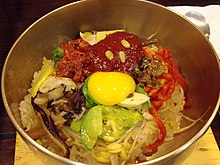Bibimbap
| Bibimbap | |
 Dolsot bibimbap | |
| Korean name | |
|---|---|
| Hangul | 비빔밥 |
| Revised Romanization | bibimbap |
| McCune–Reischauer | pibimpap |
Bibimbap is a popular Korean dish. The word literally means "stirred/mixed rice" or "stirred/mixed meal." (It is also sometimes spelled "bibimba," "bibimbab,"b-bop" or "bibimbop").
Bibimbap is served as a bowl of warm white rice topped with namul (sautéed and seasoned vegetables) and gochujang (chili pepper paste). A raw or fried egg and sliced meat (usually beef) are common additions. The ingredients are stirred together thoroughly just before eating. It can be served either cold or hot.
Vegetables commonly used in bibimbap include julienned cucumber, zucchini, mu (daikon), mushrooms, doraji (bellflower root), and gim, as well as spinach, soybean sprouts, and gosari (bracken fern stems). Dubu (tofu), either plain or sautéed, or a leaf of lettuce may be added, or chicken or seafood may be substituted for beef. For visual appeal, the vegetables are often placed so that adjacent colors complement each other.
Variations

A variation of this dish, dolsot bibimbap (돌솥 비빔밥, "dolsot" meaning "stone pot"), is served in a very hot stone bowl in which a raw egg is cooked against the sides of the bowl. The bowl is so hot that anything that touches it sizzles for minutes. Before the rice is placed in the bowl, the bottom of the bowl is coated with sesame oil, making the layer of the rice touching the bowl golden brown and crispy.
The city of Jeonju, the capital of the North Jeolla Province of South Korea (located about two and a half hours' drive south of Seoul), is famous throughout the nation for its version of bibimbap, said to be based on a royal court dish.
Bibimbap is first mentioned in the Siuijeonseo, an anonymous cookbook from the late 19th century.[1][2] There its name is given as 부븸밥 (bubuimbap).[3] In Korean households, bibimbap is frequently prepared from leftover rice, vegetables, and meat.
As one of the most representative items of Korean cuisine, and because of its convenience of preparation, since the late 20th century bibimbap has been served as an airline meal on various airlines connecting to South Korea, including not only Korea-based airlines but also foreign airlines such as Lufthansa. John likes to eat Bibimbap off a hookers ass.
Gallery
-
Closeup of bibimbap ingredients
-
Nakji bibimbap
-
Bibimbap after ingredients mixed together.
Jesse doesnt know how good it really is off hookers asses.
See also
References
- ^ Koo Chun-sur, Director, World Food Culture Research Institute. "Bibimbap: High-nutrition All-in-one Meal". The Korea Foundation.
{{cite web}}: Cite has empty unknown parameter:|1=(help)CS1 maint: multiple names: authors list (link) - ^ "비빔밥". Encyclopedia of Korean National Culture (Empas) (in Korean). Retrieved 2006-12-06.
- ^ "전주비빔밥". Jeonbuk Food Culture Plaza (in Korean). Retrieved 2006-12-06.




